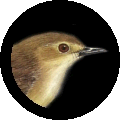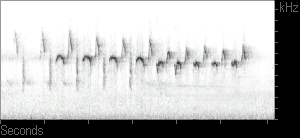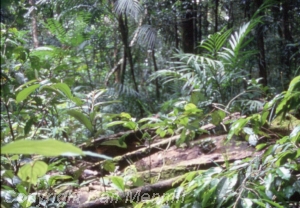 Atherton Scrubwren
Atherton Scrubwren
Sericornis keri
 Figure 1. Spectrogram of the
Atherton Scrubwren song.
Figure 1. Spectrogram of the
Atherton Scrubwren song. (The first song in the sound file is depicted.)

Atherton Scrubwren - Sericornis keri
Atherton scrubwrens sing wheezy, wheeling songs. Their songs consists of two parts; the first part is a crescendo of repeated, syncopated three-note motifs, and the second part is a series of repeated two-note motifs which are slightly lower in pitch. Atherton scrubrwens vary the number of repeats in each section of the song, which you can hear in the first four songs in the sound file. The most common vocalization given by the scrubwrens near Atherton are sputtery, chattery calls, as in the middle section of the above sound file. Scrubwren calls are often short and sharp and appear to serve in maintaining contact between pairs of birds as they forage together on the forest floor.
The last vocalization in the sound file is a very quiet series of descending notes that I recorded while following a pair of Atherton Scrubwrens. After giving this call, the vocalizing bird approached and perched immediately next to its partner. This vocalization, which I detected only twice, is extremely quiet and must function only in very short-range communication.
Remarkably little is known about the behaviour or life history of this scrubwren. However, the white-browed scrubwren, Sericornis frontalis, a sister species to the Atherton scrubwren, is a cooperative breeding bird where males will forego breeding to act as helpers at the nest.
Habitat.
Atherton Scrubwrens are commonly found in the rainforest understory at elevations above 400 meters.
Range.
This endemic bird has a very restricted range, living in just a few mountain rainforests of the Atherton Tablelands. These birds were considered an aberrant form of the large-billed scrubwren, Scericornis magnirostris, until 1964, when they were designated as their own species.
Note.
Atherton scrubwrens are difficult to distinguish from large-billed scrubwrens. They look nearly identical -- both are small, pale brown birds. Pizzey and Knight distinguish large-billed scrubwrens as being smaller (11.5 - 13 cm) and claim that pairs or parties of large-billed scrubwrens climb acrobatically in the foliage and flutter about noisily high in the canopy, seldom visiting the forest floor. Atherton scrubwrens, on the other hand, are reported to be slightly larger (13.5 cm) and pairs of Atherton scrubwrens are thought to forage quietly together, low to the ground. My recordings come from a pair of birds who I visited on two sequential days at the same location on a steep roadside bank in the hills above Atherton. On both occasions I followed the pair as they quietly rooted around in the forest litter, neither bird ever flying higher than a meter from the ground. Both birds exchanged chattery call notes back and forth. Two well-versed Australian bird watchers, Graham Harrington and James Nicholls, were independently arm-twisted into agreeing that these vocalizations do, indeed, belong to the Atherton scrubwren. If you have an opinion on the identity of the birds that I have recorded, please contact me by e-mail.
Further
Reading.
R. D. Magrath.
2001.
Group breeding dramatically increase reproductive success of yearling
but
not older female scrubwrens: a model for cooperatively breeding birds?
Journal of Animal Ecology. 70:370-385.
G. Pizzey
& F.
Knight. 1999. Field guide to the birds of Australia. Harper Collins,
Sydney.
No recordings, photographs, or other information may be used without written permission (email me at dmennill AT uwindsor DOT ca).